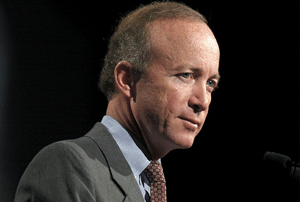New governors, new IT policies

At least one of the seven new governors taking office in 2005 has first-hand experience using information technology to improve government performance.
At least one of the seven new governors taking office in 2005 has first-hand experience using information technology to improve government performance. Indiana Gov.-elect Mitch Daniels spent two years as President Bush's director of the Office of Management and Budget, where he established strict performance goals for federal agencies and used scorecards to prod agencies toward those objectives. Companies doing business in Indiana can expect Daniels to establish similar performance goals for the Hoosier State and to take an enterprise approach to IT, industry experts said.Daniels is one of seven new governors swept in by the Nov. 2 election. Contractors will be watching them closely, searching for clues to changes in IT policies and leadership. Companies marketing to these states should study the campaign platforms of governors-elect to see how their products and solutions fit into major planned initiatives, said Thom Rubel, vice president of government strategies at research and consulting firm Meta Group Inc., Stamford, Conn."Vendors should look at their solutions in terms of relevance to those priorities, and focus on the business message to the governor around the priorities," he said.Including Indiana, 11 gubernatorial seats were up for grabs. Voters elected new governors in Missouri, Montana, New Hampshire, Utah and West Virginia. Incumbents won in Delaware, North Carolina, North Dakota and Vermont. The race in Washington between Democrat Christine Gregoire and Republican Dino Rossi was too close to call, and state officials were still counting provisional and absentee ballots at press time.Indiana likely will be one of the strongest market opportunities to surface from the new governorships because of Daniels' knowledge of IT as a business management tool.Gerry Wethington, Missouri CIO and a former president of the Lexington, Ky.-based National Association of State Chief Information Officers, said Daniels will have some assets to work with in Indiana that he didn't initially have within OMB, namely an enterprise architecture program and education network programs. "Daniels understands that technology can be used to drive efficiency in government," Wethington said. "Given the fact that his cupboard is not bare and that he has the kind of vision that he has, I would expect he will be effective in implementing some successful programs in Indiana using IT as a quiet contributor to success." Vendors crafting their marketing strategies for Indiana "should watch the message [Daniels] is sending in terms of how he will use IT to drive performance objectives and drive down costs," Rubel said.Indiana CIO Laura Larimer could not be reached for comment. Another state to watch is Missouri, where Wethington will step down Nov. 30 after four years under Gov. Bob Holden (D), who lost the primary election to State Auditor Claire McCaskill.[IMGCAP(2)]Wethington's resignation leaves a vacuum that may be tough to fill, Rubel said. During his tenure, Wethington established Missouri's enterprise architecture, consolidated data centers and optimized networks.As Missouri's former secretary of state, Governor-elect Matt Blunt is intimately familiar with the way state government works. "It will be interesting to see if he takes advantage of IT at the operational level," Rubel said. Already there are indications that Blunt wants to build on the IT foundation by continuing to consolidate and adopt emerging technologies to improve government operations and performance, Wethington said. There's no hard and fast rule in state government about whether a governor should replace a CIO when taking office, said Tom Jarrett, NASCIO president and Delaware's CIO. Whether a CIO is replaced depends on whether it is a prominent, cabinet-level position and whether the incoming governor views IT as a useful tool or merely an additional business expense, he said. These days, governors tend to look for people with private-sector experience when appointing CIOs, because governors who understand technology recognize that it can drive down costs while improving services, Rubel said.Jarrett agreed. NASCIO recommends that governors appoint a business manager with a technology background as CIO, as the job is more about managing people and establishing strategic direction than understanding the finer points of technology."The pure technologists don't necessarily make the best managers," he said. Eventually, governors may appoint CIOs with a pure business background and no technology background, Jarrett said. He did warn that incoming governors should not fill the CIO position with a political appointee. "This is not the place for a political appointment," Jarrett said. "There may be other places for those, but this is not the place."Staff Writer William Welsh can be reached at wwelsh@postnewsweektech.com. XXXSPLITXXX-State technology leaders want federal funding for homeland security to shift from incident response to prevention during President Bush's second term.The change in focus would drive information sharing and new technologies for detection and prevention related to bioterrorism and critical infrastructure prevention, said Thom Rubel, vice president of government strategies for research and consulting firm Meta Group Inc., Stamford, Conn.State officials who advocate this shift said during the president's first term, the federal government placed too much emphasis on funding for first responders at the expense of incident prevention and infrastructure protection."We've seen troubling signs that homeland and cybersecurity are not being taken as seriously as they should be," said Tom Jarrett, president of the Lexington, Ky.-based National Association of State Chief Information Officers and Delaware's chief information officer. "We hope that is going to change. We want to see more of an effort." The federal government has focused primarily on physical assets for homeland security rather than cyberassets, said Gerry Wethington, Missouri's chief information officer. But federal guidelines for homeland security call for creating enterprise architectures to promote information sharing among different government programs in order to prevent incidents and harden critical infrastructure, he said.Most of the federal funds were spent on first responders, leaving little or no funds for state IT in other areas, such as education, e-government and health care, Wethington said. "There is a balance that needs to be struck," he said.Jarrett said he expects the administration and Congress to provide more funding for prevention because of growing awareness among lawmakers and the public that the nation's IT infrastructure must be protected along with the physical infrastructure, such as airports, highways and seaports. Outside of homeland security, states should expect to see the same level of funding for federally mandated health and human services programs that they administer, Rubel said. "They will have the benefit of consistency there," he said.But should the president decide to tackle the budget issue head on, it will have a negative impact on virtually every area of federal funding to states, he said. "If that were to happen, I have to believe [states] would see less money overall," Rubel said.



IT contractors will be closely watching Indiana Gov.-elect Mitch Daniels to see how IT will fit into his planned initiatives.
Ricky Carioti

Missouri CIO Gerry Wethington said Mitch Daniels "understands that technology can be used to drive efficiency in government."
J. Adam Fenster

